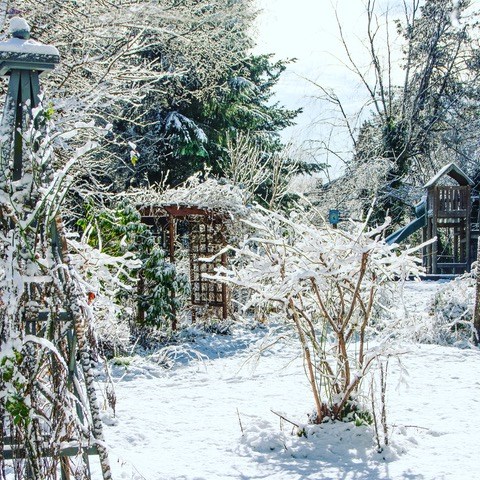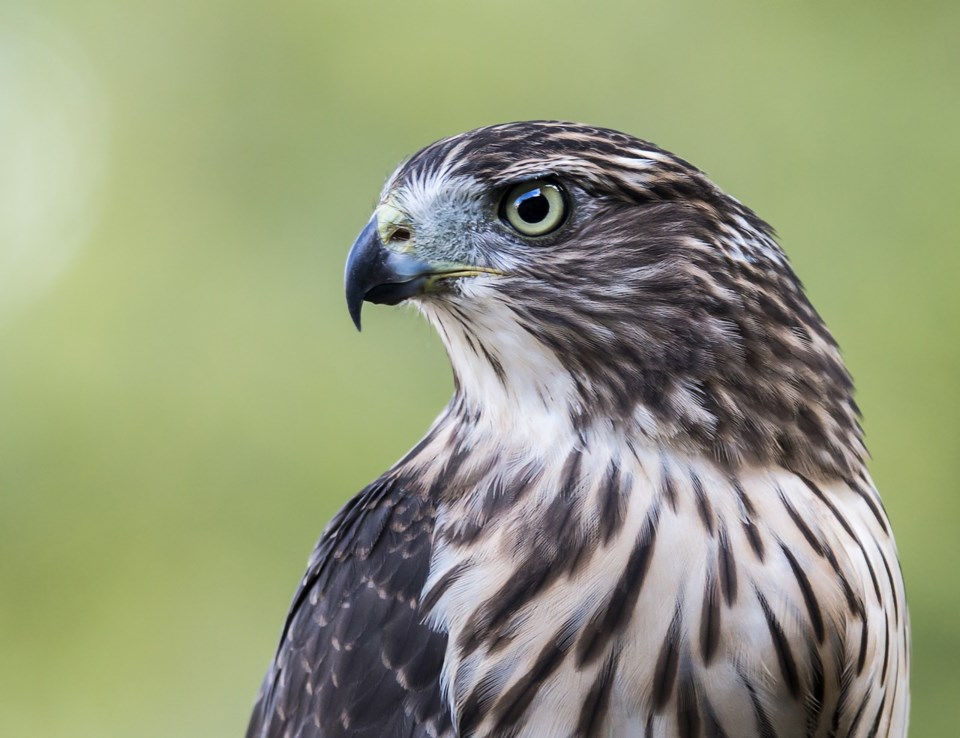In between rain drops, we work in the floral garden beds in Paulik Park to get them all ready for showcasing their brilliant colours in the spring.
While we are digging and trimming, our winter birds are keeping an eye on what we are up to. There may be opportunities to dine on some juicy earthworms or other bugs that suit their palate.
While we were trimming up some shrubs in the forest area of the Park, a large bird flew in and peered down on us. We were able to walk right up to the base of the tree and gaze up at this magnificent creature.

It turned out to be an immature Coopers Hawk, a fairly large raptor about the size of a crow. The breeding range of the Coopers Hawk extends from southern Canada to northern Mexico.
Most likely, our hawk was on its way south as they do migrate in the winter and have been found as far south as Panama.
It is quite the show watching these birds capture their prey. They fly at great speeds right into dense vegetation and come out the other side with a robin or other unsuspecting bird. They hunt on the element of surprise but can hurt themselves quite badly with this type of high speed hunting.
They feast on robins, thrushes, jays, woodpeckers, starlings, pigeons and many other species of birds dwelling in our park.
Flickers and woodpeckers are very active right now, feeding on insects on the many trees in the park. We can hear their rat-tat-tat while working away. They too, like to stay close to us to see if we stir up any insects that are on their daily menu. Flickers have a high pitched whistle that pierces the silence of the gardens while we are working.
The most prolific bird in the park right now is the Anna’s Hummingbird. These crazy little birds stay for the winter and can be heard protecting their territory with an explosive squeak even on the most wintry day.
In the early 20th century, these little creatures only bred in the very southern part of California and into the Baja. Because of our love for exotic ornamental plants, Anna’s have expanded their breeding range as far north as our region in the Pacific Northwest. They have been spotted as far north as southern Alaska.
In the winter, Anna’s gain more weight as they gradually turn sugar into fat. Many of us keep feeders out for these little birds filled with a blend of one part white sugar to four parts water. Every morning, we find our little hummingbird sitting on a branch right next to our window, greeting us with its feathers all fluffed up guarding the feeder from any other visitors.
In Paulik Park, the over wintering hummingbirds feed on nectar from flowering Mahonia x media ‘Lionel Fortescue’, witch hazel (Hamamelis), Viburnum x bodnantense ‘Dawn’, Camellia sasanqua ‘Yuletide’ and sweetbox (Sarcococca).
Just as we were wrapping up our work in the park recently, two bald eagles flew in and settled on the top of a massive cedar tree. We were pretty sure they were husband and wife arguing over which part of the tree would be the best place to settle. We have our fingers crossed that these two will decide to build a nest in our park next spring and become permanent residents.
Take some time to get out to your local parks and envelope yourself in the natural world around you. You will be amazed at how much of the wildlife you will see in the middle of our busy city.
Lynda Pasacreta is the current president of the Richmond Garden Club. For more information visit richmondgardenclub.ca.



